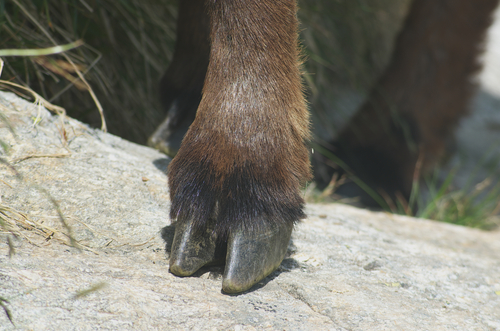

If the goat’s feet have been neglected for some time, and the toes are very long it is usually not practical to try to bring them back to normal in one trimming. It is generally better to trim the feet a little, then gradually bring them back to proper shape, size and angle with frequent trimmings.
A general rule to keep in mind about trimming goat’s feet is that the hoof’s hairline should be almost parallel to the ground and the more often trimming is done the less time and energy per trimming it takes, and the more well behaved the goats will be during the trimming.
There is a smaller chance of the goat developing foot problems such as hoof rot if the owner is working with the goat’s feet regularly and frequently.
One of the most common problems is the development of foot rot. This disease is caused by a mixed infection of two bacteria, Fusobacterium, necrophorum and Bacteroides nodosus, which are brought into an area by way of contaminated feet. Wet soils and filth increase the possibility of disease outbreaks. Also, injuries to the feet enhance the transmission of foot rot, although it usually does not occur when the soil temperature is less than 40 degrees F (4.5 degrees C).
Generally, this disease starts as an inflammation between the toes of the foot, later spreading under the hoof. As it continues, it causes a separation between hoof and skin, causing varying degrees of pain and lameness. The foot rot bacteria require an anaerobic (without oxygen) environment to survive. Therefore, in order to correct this problem, the hoof must be trimmed back to the point of separation so that the area will be exposed to the air. This also rids the hoof of a potential “pocket” in which dirt and manure could contribute to an anaerobic environment. The foot is then treated with an antibiotic spray, or soaked in a 10% formalin, copper sulfate or zinc sulfate solution and kept off contaminated fields or muddy yards for at least two weeks to avoid reinfection. A walk through foot bath filled with saturated copper sulfate or zinc sulfate solution will also aid in maintaining sound, healthy feet; provided the foot bath is kept free of contamination from manure, rain and run off.
An added benefit to proper hoof trimming is that some foot and leg problems can be ”cured” by corrective trimming. If the hind legs are post legged or too straight, leaving the toes a little long may help give the leg more angle. Viceversa, a sickle hocked leg will benefit from trimming the toes short to a greater than 450 angle. If the legs toe out, trimming the total inner claw shorter and lower on each foot will help. If hooves have spread claws, then cutting the inner walls more than the outer walls, is good corrective hoof trimming, provided it is done frequently and in short intervals.
 Contact Jaguza Support
Contact Jaguza Support